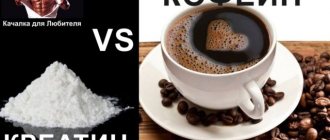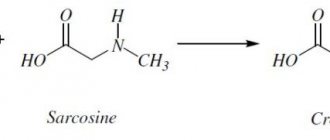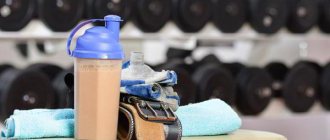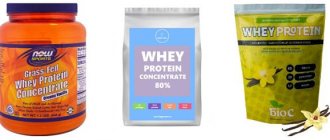Creatine supplements may help build muscle mass and strength, improve performance during high-intensity exercise, and prevent sports-related injuries (,).
Research shows that a creatine loading phase can quickly increase your reserves, allowing you to see results faster.
This article reviews the benefits and side effects of the creatine loading phase.
Creatine: application features and dosage
Content
Creatine is one of the most popular nutritional supplements designed to increase muscle mass, strength and endurance. Used by professionals and amateurs of both sexes, it is also useful for women. The most effective form of creatine monohydrate is considered to be in powder form. Also available in tablets, capsules, and liquid.
Creatine is produced in small quantities by the human body and comes with food (red meat). But this is not enough to maintain the required level, and it is destroyed quickly. The diet of every physically active person should include creatine monohydrate as a dietary supplement. The optimal daily intake for an adult is on average 5–7 g of pure creatine. It is calculated individually depending on the method of application and the desired results.
Monohydrate is the popular and purest form of such effective, important and beneficial creatine.
The supplement is definitely useful and safe. Side effects from creatine are extremely rare:
- water retention in the body;
- dehydration;
- indigestion;
- spasms and cramps;
- acne on the skin.
Numerous studies have proven that these phenomena are not always directly related to creatine intake and do not cause significant harm to health. To minimize any unpleasant consequences, let’s figure out how to load with creatine correctly.
Rules for taking creatine monohydrate
Creatine helps you gain muscle mass faster, improves your workout performance, and reduces recovery time. But not everyone experiences these effects. In most cases, the problem lies in the incorrect use of the supplement.
The maximum result is possible only if the rules are followed:
- it is necessary to select an individual dosage regimen, where a loading phase of creatine is present or creatine monohydrate is taken without loading;
- divide the daily norm into several doses, one of which must be after training;
- for dilution or washing down, use at least one glass of liquid;
- the course lasts 1.5–2 months, after which a month’s break is taken;
- do not reduce (less than 3 g per day does not produce results) and do not exceed (the risk of side effects increases) the recommended dose.
Professional athletes are increasingly using creatine during cutting
If all the nuances are observed, creatine will be useful not only for bodybuilders, but also for track and field athletes, runners, football players, boxers and just amateurs striving for a sculpted figure.
How to take monohydrate - before or after training
Scientific research has shown that the best time to take creatine is after a workout. At this moment, metabolic processes and blood circulation are activated, which contributes to its greatest absorption. As a result, whether creatine is taken with or without loading, muscle growth and strength gains are enhanced.
It is not advisable to drink the supplement before and during sports activities for two reasons:
- possible disturbance of water balance;
- Transient dehydration may develop, especially when using a creatine complex with a transport system.
On rest days, it is better to drink monohydrate in the morning on an empty stomach and before bed. At this time it is best absorbed.
Regular use of the supplement allows you to quickly restore and maintain creatine levels in the body, achieving the desired athletic results.
When is the best time to take creatine?
In order for training to be extremely effective, it is necessary to monitor nutrition and time intervals. This factor directly affects the results. For this reason, you need to carefully approach your food intake. It should be distributed so that creatine is better absorbed. It is important to remember that the best time to take supplements is after intense training. During this period, blood flow in the veins improves and metabolic reactions intensify.
If an athlete is a beginner, the first thing he should do is decide how to take creatine without loading, so as not to harm his body. In such situations, you should reduce your intake of the sports supplement. Before starting an intense workout, you should not drink creatine, as it may upset the balance of water in the body.
During rest days, supplements should be taken in the morning. This is because at this time of day the body is saturated with growth hormones. Creatine improves metabolism, thereby allowing the carbon element to penetrate directly into the muscles.
Is creatine loading necessary: details about methods
In the sports environment, two methods of using nutritional supplements are common. They are both effective for building muscle mass, strength and endurance, increasing training productivity and pain-free recovery, but they differ fundamentally in their dosage regimen and goals.
Creatine monohydrate helps improve athletic performance not only in bodybuilding
This is about:
- loading with creatine;
- non-boot method.
What are they, and what is the best option to choose?
Conclusion
Creatine monohydrate is an important “building block” in achieving athletic performance. The main thing is to correctly decide on the dosage regimen and strictly follow the dosage. As for the loading phase, it is justified only with two options:
- the fastest possible result and effective “drying” are needed (in preparation for competitions);
- if you have extensive experience and create your own supplement regimen.
In other cases, monohydrate can be taken according to the classical regimen - 5 grams per day. As a rule, this is quite enough to replenish all reserves. Good luck.
Taking creatine monohydrate with loading
Creatine loading is the process of saturating muscles as quickly as possible by taking large doses of the supplement daily. Until recently, it was considered the most effective method of using monohydrate and was used to rapidly increase muscle mass and quickly achieve high athletic results.
Creatine loading is carried out in two stages:
Loading phase
The first phase of saturating the body with creatine lasts 5-7 days. During this period, take 20 g of powder per day. It is recommended to divide the daily dose into 3-5 doses, one of which occurs after training. During these days, the muscles have time to be saturated with creatine in the required amount. Important: the body does not consume more creatine than nature intended. Excess is excreted in the urine; exceeding the dosage is absolutely useless.
Taking creatine is very useful for vegetarians who deny themselves meat products.
Maintenance phase
Designed to maintain high levels of creatine in muscles. After the 7-day loading phase, it is necessary to reduce the daily dose to 3-5 g. Take a serving once a day - after training or in the morning. This period lasts approximately 3 weeks.
The loading method involves taking the supplement for a month, after which a break is taken for 3-4 weeks, then the course is repeated.
Despite the fact that this classic method is somewhat outdated, it has not lost its relevance, especially for professional bodybuilders before important competitions.
Is Creatine Loading Safe?
Scientific studies have revealed that loading provides a short-term effect in the form of accumulation of useful substances at an early stage of use. However, at the end of the month, the results of use were the same both in the case of moderate dosage and with intensive use at the beginning of the course. This gives reason to assert that both forms have the right to exist.
There is also an opinion that the cavities for accumulating acid in muscle tissue are limited in volume, and with increasing dosage they will quickly overflow. The consequence of this will be the removal of excess from the body. In this way, you can lose more than half of the useful elements and significantly reduce the effectiveness of the course.
Taking creatine monohydrate without loading
The no-load method is considered the simplest and most optimal. It involves using the same doses of creatine for 2 months. This method is popular among beginners and amateur bodybuilders. A leisurely and uniform rhythm allows you to replenish reserves gradually, stably maintaining a sufficient level.
Differences with boot method:
- no different dosing is required, the athlete takes 5 g of creatine once daily;
- the optimal course is designed for 2 months followed by a 20-30-day break;
- The maximum level of monohydrate is recorded on the 28th day of use, while the loading phase gives the highest concentration already on the 6th day.
Creatine monohydrate is an important “building block” in achieving athletic performance.
The use of this regimen has its advantages - minimal risk of side effects, less product consumption. With the no-load method, the result will also be positive, but its achievement will take a little longer.
How to use?
Today there are two popular schemes. Both of them have the right to life and are effective in their own way. Based on them, you can determine your strategy, which can subsequently give the maximum. So, let's look at each of the options:
- Normal mode (no download). This option is most preferable for beginners who are just taking their first steps in bodybuilding. The point is simple. On training days (after classes) and on rest days (in the morning), you need to drink 5-8 grams of creatine. The monohydrate is washed down with sweet juice or water. It is possible to add gainer, amino acids or protein. The duration of such a course should not exceed 60 days. After this, it is important to give the body “rest” for 20-30 days.
- Special mode (with loading). As a rule, the loading phase is increasingly used by professional athletes. The peculiarity of this scheme is the large dosage and the presence of two periods:
- For the first 6-7 days, take 20-30 grams of creatine (number of doses – 4-6 times a day). This is precisely the loading phase, when all empty reserves are replenished and the concentration of creatine increases;
- the rest of the period (about a month) the dosage is reduced to 4-8 grams per day. In this case, the total duration of the course does not exceed one month.
Just as in the first case, it is recommended to drink monohydrate along with other sports supplements or wash it down with a sweet liquid (water, juice). One of the portions in the loading phase should enter the stomach after training (this is mandatory). This is when creatine monohydrate is believed to be absorbed best and provide maximum benefits.
Until recently, the second option was considered more effective. Modern research has largely refuted this belief. Studies have shown that loading is not a prerequisite for achieving results - 5-7 grams of creatine per day is enough to provide the body with the necessary substance 100% (even during active training).
Of course, loading has an advantage - you can get quick results from training. But the disadvantages cannot be ignored - an increased risk of side effects and excessive consumption of sports supplements.
What is creatine taken with?
One of the most important aspects is the delivery of creatine to muscle cells. If the process goes wrong, most of the substance is lost and has no effect. A special transport system is needed to transfer it from the blood to the muscles.
The regimen for taking creatine monohydrate with loading involves several options for such transporters:
- insulin is a hormone that stimulates the absorption of nutrients by muscles;
- fast carbohydrates – improve the absorption of the supplement;
- fast protein;
- BCAA amino acids.
For better absorption of the supplement, the powder must be stirred or washed down:
- one glass of plain water with sugar;
- sweet fruit juice;
- special gainer;
- protein shake.
The amount of liquid should be sufficient to prevent disturbances in water balance - at least 250-500 ml. The absorption of creatine is positively affected by the simultaneous use of other sports supplements, as well as anabolic steroids, the hormones thyroxine, somatropin, and insulin.
Whether you're in a creatine loading phase or take small doses of creatine daily, supplementation can help you restore creatine levels in your body faster.
Is this really necessary?
While the goal of the creatine loading phase is to increase your body's creatine stores, it may not be necessary to increase your overall creatine levels.
In fact, lower doses taken once daily may be equally effective at increasing muscle creatine stores—although it may take a little longer.
For example, one study found that muscles became fully saturated after people took 3 grams of creatine daily for 28 days.
Therefore, to maximize muscle creatine stores with this method, it may take you about three weeks compared to the loading phase. Therefore, you may have to wait to see the positive effect (, ).
Summary:
It is possible to completely saturate your muscles with creatine without going through a loading phase, although this may take longer. Thus, it may also increase the time it takes to get the effects of taking creatine.
List of Effective Supplements
Creatine is produced by many sports nutrition manufacturers in different forms. It is recommended to use the following brands of powdered monohydrate:
- Dymatize Micronized creatine – high-quality micronized creatine from the American company Dymatize Nutrition;
- NO-Xplode from premium sports nutrition manufacturer BSN - pre-workout creatine complex with a transport system;
- Creatine Monohydrate from Ultimate Nutrition - 100% micronized creatine to increase strength;
- Nutrex Hemo Rage Black is a multi-ingredient extreme energy supplement;
- Micronized Creatine Powder from Optimum Nutrition is a nutritional supplement suitable for professional athletes and beginners.
When purchasing, it is important to pay attention to the manufacturer so as not to purchase a fake, of which there are many on the sports nutrition market.
Answers to your questions
An athlete, like any person, needs rest. Gatherings in a friendly company are usually accompanied by drinking alcoholic beverages. Many people wonder: are taking creatine and alcohol compatible? Playing sports, in principle, eliminates bad habits, but there is no strict prohibition regarding supplements. Creatine and alcohol on weekends are not mutually exclusive. A glass of good wine at the holiday table will not in any way affect the effectiveness of sports nutrition and will not harm your health. Large doses of alcohol should be completely avoided.
Finally, let’s answer the main question: why is creatine used in bodybuilding? Creatine supplement occupies a leading position in effectiveness and availability. With her help:
- a professional bodybuilder will increase protein synthesis in the body, strengthen the muscle corset, and improve athletic performance;
- a beginner will increase physical endurance and strength, training productivity, gain muscle mass faster, and acquire ideal body shape.









